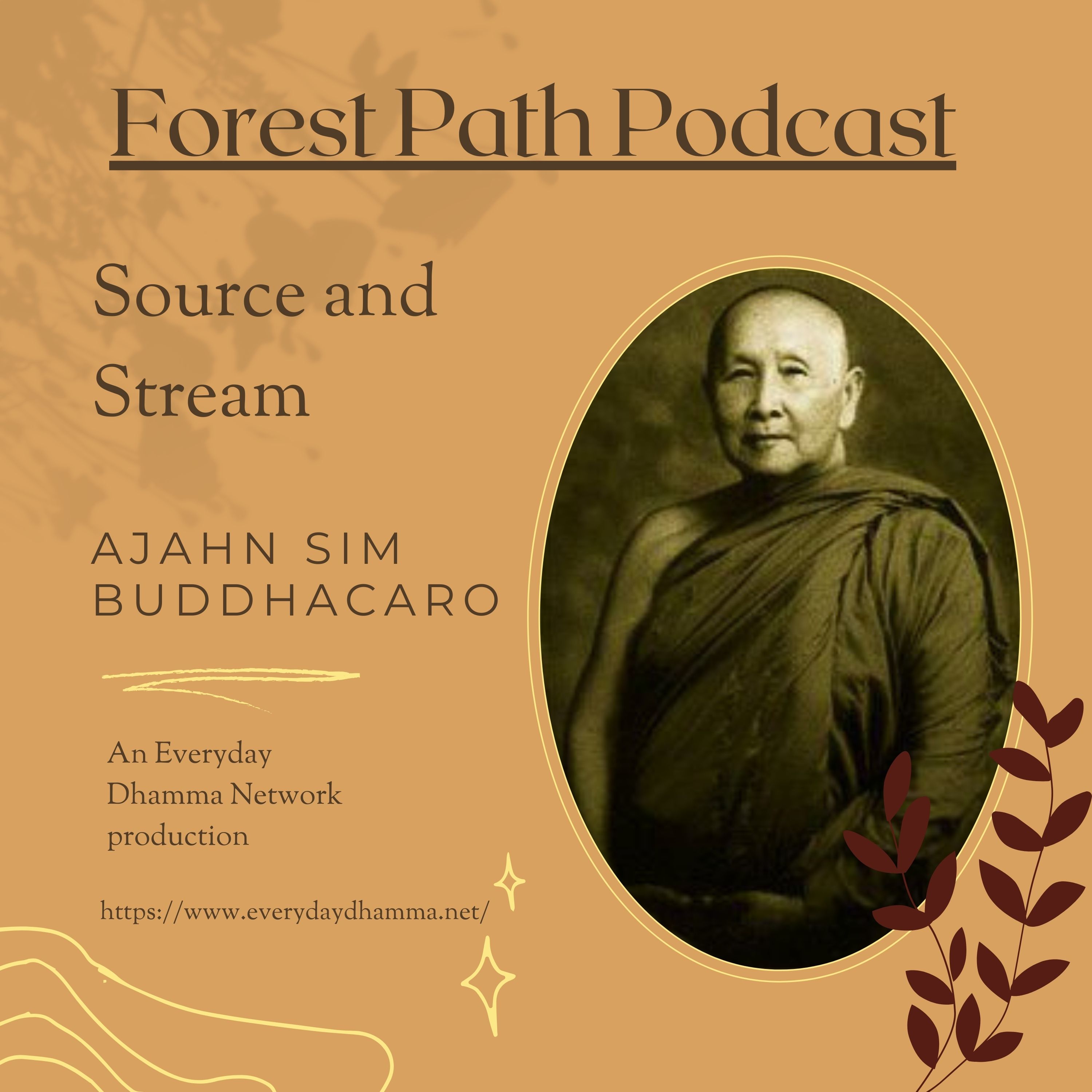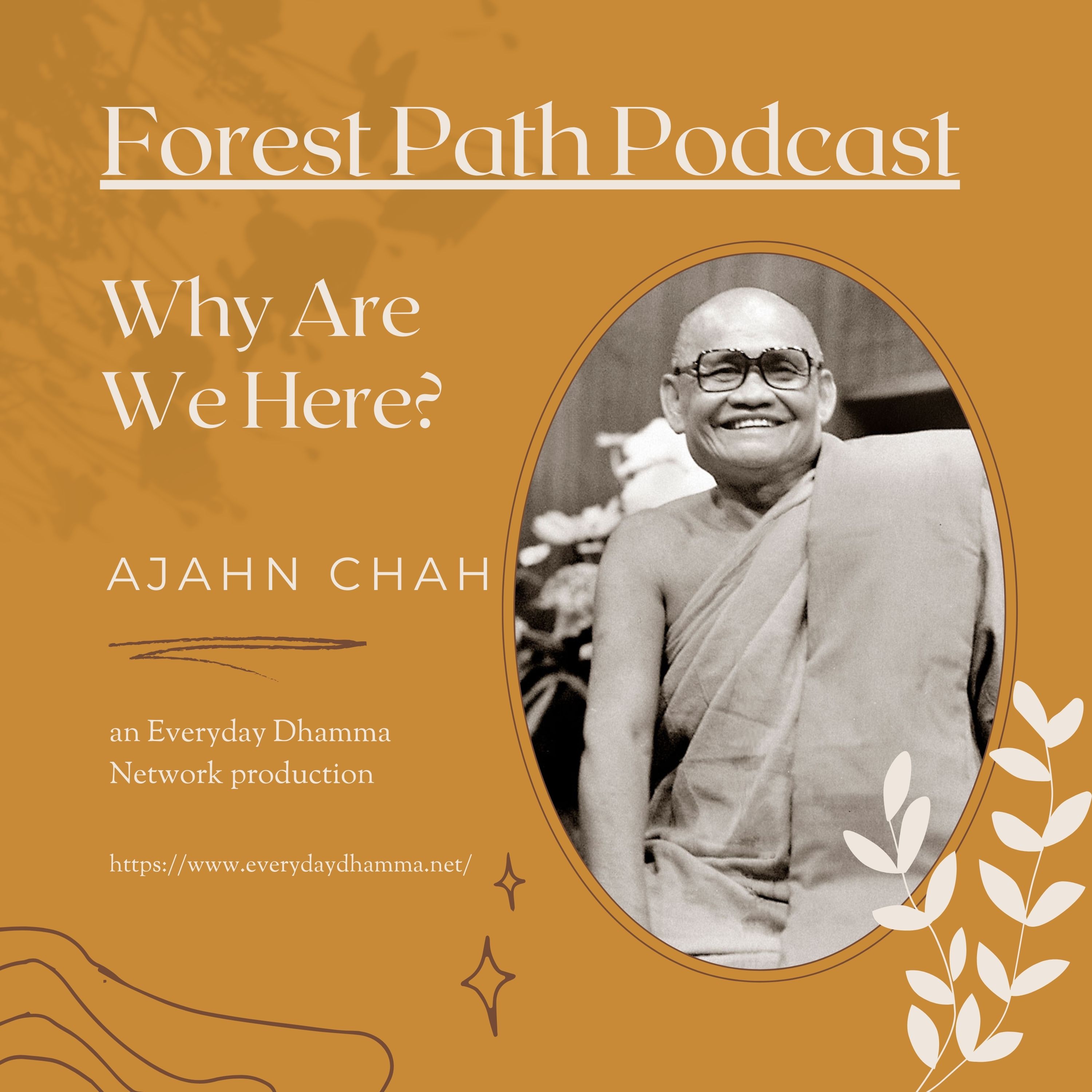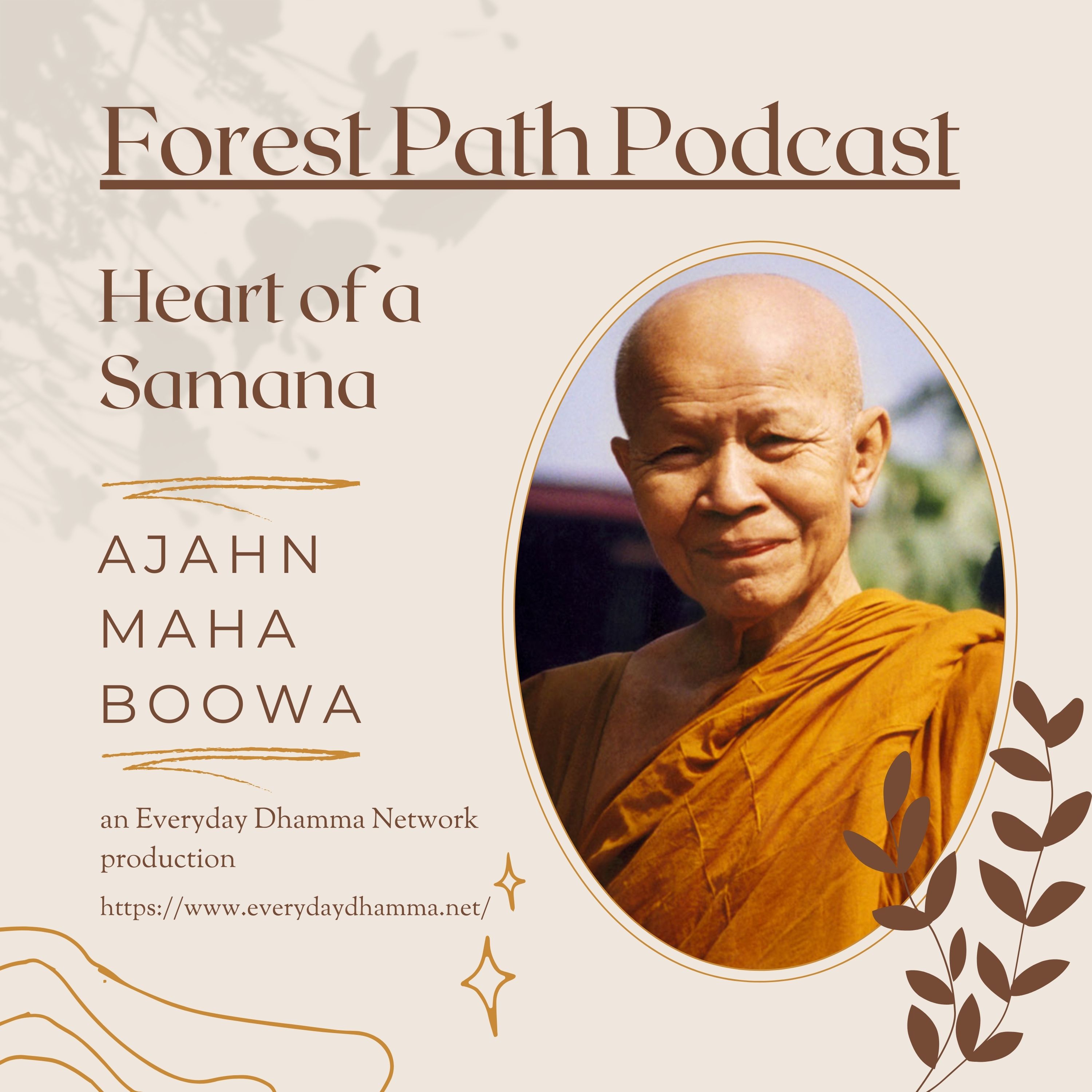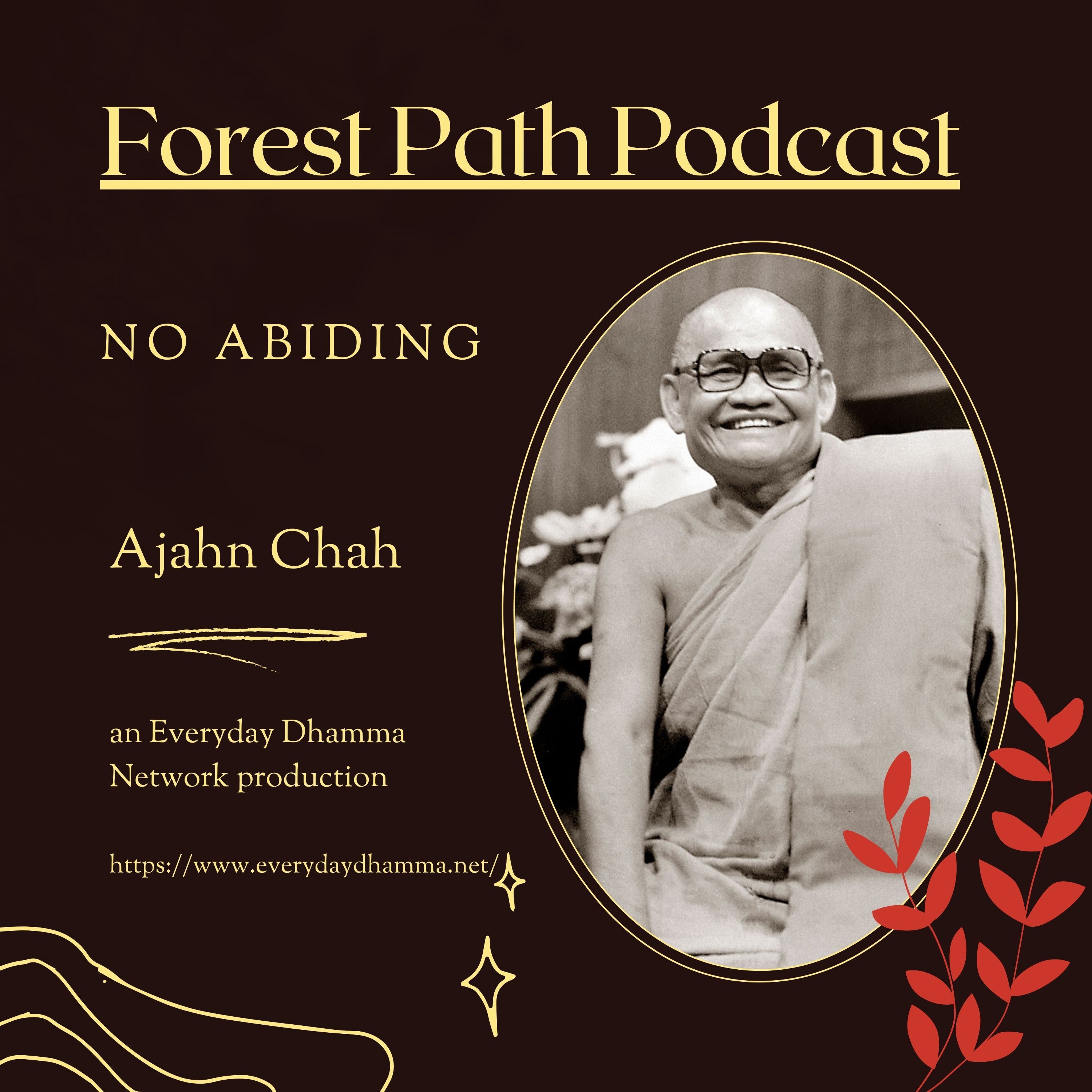Episode Transcript
Source and Stream
Now it is time for sitting meditation. Sit in the cross-legged posture; place the right leg on top of the left leg and the right hand on top of the left hand. Close your eyes and inwardly recite the mantra "Buddho" in conjunction with the breath. Concentrate the mind on Buddho. Sitting meditation is an important way of paying homage to the Buddha.
The Buddha called all our former experiences, irrespective of their quality, (presently existing) thoughts of the past. Now, in this moment, do not allow such thoughts to preoccupy the mind. Let them all go. Concentrate the mind on the inner recitation of the mantra and bring the mind to peace in the present, in the immediate reality. It is the present moment that is important. Future matters, good and bad, all still lie ahead, for by definition the future refers to things that have not yet taken place. The meditator must compose his mind on the present moment. If a thought surfaces in consciousness simply remind yourself that it is just a thought of the past, or a thought of the future, as the case may be. Don't add to or encourage such thoughts. Put good thoughts to one side for the time being and the bad ones abandon altogether.
Sitting here, our bodies are in a tranquil posture. The knowing is abiding within the heart, and each one of us is aware. This present knowing is our true mind. The conditioned mind of thought and proliferation is almost like a demon. Through its actions external phenomena tend to become preoccupations which then obstruct or destroy meditation. But if the meditator grounds himself in the present moment then he is able to make use of the various meditation techniques. He may develop inner recitation for example or perhaps focus on parts of the physical body such as head hair, body hair, nails, teeth, skin, sinews and bones. When contemplation of the body ensues in perception of its unattractiveness, or of its constituent elements of hardness, cohesion, temperature and vibration [1] then that is meditation. When the mind is at peace in the recitation of "Buddho," then that too is meditation. And the meditator is the mind.
The mind itself has no color, shape, or form, but it has energy. It is our duty to let go of and abandon the conditioned, proliferating mind. But the mind of present knowing, that which concentrates on Buddha, listens to Dhamma and reflects on its meaning, having been clearly observed, that true mind should be developed. In this case to "develop" means to give care and attention to establishing it in peace. Peace comes by countering the out- going stream of mentality and penetrating this present knowing.
The normal unrestrained mind is absorbed by the thought-consciousness seeking distraction. Go against the stream by looking at the source of mental activity. It originates from this knowing. The source of the mind lies within us. However this knowing is nothing substantial. It has no color, form or shape in the way that material objects do. It is a formless element. To speak in terms of the five aggregates there is:
• rupa -- these bodies of ours;
• vedana -- the experience of objects as pleasant or unpleasant, comfortable or
uncomfortable;
• sañña -- discrimination based on memory -- e.g., that this is a human being and this is an animal; this is red, this is black;
• sankhara -- conditioning mental activity;
• viññana -- cognition conditioned by mental activity.
The four formless aggregates of vedana, sañña, sankhara, and viññana arise within the knowing. The Buddha taught that during sitting and walking meditation we should make the knowing converge on itself, not allowing it to go outwards. Thoughts of good and bad are all exterior matters and are endless. In thinking and cognizing we must know the thinker, know the knower. All movement proceeds from this present knowing. That being the case, don't be deceived by these expressions of mind. They are merely shadows, flitting off into the past and future, thinking about and elaborating on the things that we like and the things that we don't. This proliferation is what conditions the mind.
What is it that knows the true mind and what is it that knows the conditioned mind? It is just this one single knowing, the same thing that hears the sound of the discourse and meditates on "Buddho." As there is just this single knowing, muster your energies and vow to yourself "I will not indulge the thinking mind. I will gather the mind into itself." Not allowing the mind to wander means that it stays with Buddho. All you have to do then is to maintain Buddho.
"Buddho" is the name of the Fully Enlightened One and should be reflected on. That we have come into contact with Buddhism, with Buddha Dhamma and Sangha and that we have come to practice, is due to the Buddha. The Buddha, after realizing supreme enlightenment, gave to the world the teachings of Dhamma-Vinaya that we call Buddhism. The great teachers of old and the four assemblies of Buddhists have carried on the study and practice of the teachings right up until the present time. In Thailand today, everywhere we go we see monasteries, monks and novices, eight-precept laymen and laywomen, and householders with faith and inspiration in Buddhism. This is all thanks to the Buddha. It has been a long time -- over 2,500 years -- since the Buddha entered final nibbana. Even so, the Dhamma and Vinaya, the teachings and the ordinances based on the 5, 8, 10 and 227 precepts, still remain.
We bring the virtues of the Buddha to mind in order to be able to take him as an example in our practice. Where did the Buddha come from? He came from the mind that resolved on Buddhahood and wished to ferry all beings to nibbana. From the moment of his initial resolve, in whatever realm the Buddha-to-be was born into, then whenever he performed acts of charity, refrained from unvirtuous actions and speech, or practiced meditation, then Buddhahood was always his motivation. Whenever he was born as a human being he accumulated virtue. Eventually the power of goodness created by his dana, sila, and bhavana, the paramis (perfections) that he had developed, were strong enough for him to become Buddha. Now in recollecting the Buddha, we take his virtues as our object.
"Buddho" refers to the Lord Buddha and the one who inwardly recites "Buddho" is just this mind. It is just this mind that recites Buddho, knows Buddho, knows the breath and is aware while doing so that one is creating virtue. This mind has always been here. The knowing has been born into the world countless times, but because ignorance and craving have overwhelmed it, our dana, sila, and bhavana have been insufficient to free us from the mass of suffering with which the human organism is fraught. So we must muster our energy with firm resolve, taking meditative calm as our foundation. The principles that will lead us out of this world and the mass of suffering are those of samatha (calm) and vipassana (insight) meditation. The mind must be firmly one-pointed, tranquil, cool and at ease with samatha before vipassana is feasible. If the mind is still in movement, drifting and infirm, still not tranquil and motionless or one-pointed, it is impossible for understanding of the nature of things to take place.
Take as example the founder of our religion, the fully self-enlightened Buddha. Before his enlightenment he practiced calm meditation using the breath as his initial object. On the day of his enlightenment he practiced this way. On the in-breath he focussed intently on the in-breath. On the out-breath he focussed intently on the out-breath. All mental agitation and movement ceased, leaving only the in-breaths and out-breaths remaining. The Lord's mind was focussed intently on the breath until his mind became calm, cool and easeful, attaining the firmness of khanika, upacara, and ultimately the unwavering appana samadhi. [2] When the Buddha-to-be's mind was thus unwaveringly and undeviatingly single-pointed vipassana took place: there was clear knowing of the body and mind as impermanent, of all beings and phenomena as transitory. He saw the suffering inherent in being born with a body and mind and he saw selflessness. He realized that the perception of an abiding self is based on delusion.
In order to clearly know these three characteristics of aniccam, dukkham, and anatta the mind must be firm. Thus the effort to bring the mind to a secure and steadfast tranquillity, not allowing it to become fascinated by forms, sounds, odors, flavors, physical sensations and mental phenomena is the essence of meditation techniques, and something we must all develop. Take care when the eyes see forms not to let the mind waver: keep up the inner recitation of Buddho. Take care not to be deluded when hearing sounds: beautiful or ugly sounds are all just worldly conditions. Maintain the mind's firmness. The pleasant and offensive odors that contact the nose -- know them, don't be deceived by them. No matter how delicious the taste of the food on the tongue -- remain equanimous. Be impassive to the various physical sensations whether hot or cold, hard or soft. This is the supreme practice in Buddhism. So gather your energies and establish the mind in the present moment.
In general, meditator's minds are not unified and tranquil in the present moment -- they are wandering up ahead and back behind, taking up external matters concerning other people and dwelling on them, finding pleasure and satisfaction in agreeable mental states. They are caught up entirely in superficialities. Although the mind of simple knowing is already present within us, unless we bring it to the fore through meditation, we will be unable to perceive the truth of suffering.
When suffering arises in the body, contemplate it so that the mind will accept it for what it is. When physical illness occurs, the grasping mind starts clinging to the idea of being ill. In fact it is the earth-element that is unwell. If the meditator's mind is stable and clearly sees the three characteristics he will simply regard illness as an affair of the elements. He knows that the mind is formless and not subject to such pains. It is due to clinging to the idea of self, and that the body belongs to self, that mental suffering arises. In fact this body is merely elements and it is the elements that are sick. It is the earth, water, fire and air elements that are disturbed. If one can separate things in this way then the mind rests at ease. Whatever occurs in the physical body, there is no clinging to it as belonging to self. It is seen as simply a matter of elements, a matter of aniccam dukkham anatta, it is just the nature of things. [3] The present knowing clearly, truly and constantly. The mind is cool, no longer hot with clinging.
Suppose someone harshly scolds or maligns us. Even if they abuse us right to our faces, if we don't cling, it ends right there. What has arisen passes away. But if the knowing is misled it grasps at this body and mind as being self. When someone speaks to us harshly we get angry: "That's nothing to do with me!" Due to clinging there is "me" and "mine." It is just this clinging that is the cause of suffering, agitation, turmoil and disease.
The Buddha taught us to let go of all external affairs during meditation: whatever physical or mental distress arises is just the suffering of the aggregates: don't let the knowing suffer. Meditate in order to attenuate the defilements of greed, hatred and delusion and ultimately bring them to an end. When the knowing is still deluded and clings to the idea of self, to "me" and "mine," then it takes birth. Perhaps it becomes an animal, a human being, a celestial being, Indra or a Brahma god. But whatever it becomes, it suffers just in being that. As long as there is still clinging to the elements and aggregates, to name and form, and there is no awareness of the way to abandon defilements, then there is suffering in the world. The five aggregates are classified as suffering in the world, for when one clings to them as "me" and "mine" then right there the mass of suffering appears. We sit right on the pile of suffering, in the midst of the fire of craving, hatred and delusion. The fire flares up and constantly burns our heart.
We are meditating now so as to gather the mind into the knowing, in order to put out the fires that are burning our hearts. Don't harbor the fire of anger. Abandon it. There is no need to get angry with anyone. If you feel any jealousy or ill-will towards anyone, give it up. Don't allow the mind to indulge in it. This is cleansing the knowing both day and night, whether standing, sitting, walking or laying down. It is not clinging to "me" and "mine." The aggregates do not belong to anyone, they are something natural to the world. As soon as the knowing is born with a name and form it tends to grasp onto that name and form as self. But can that name and form last indefinitely? If it could, nobody would die, nobody would become ill, nobody would experience pain or get old, because the aggregates would do what they are told. It is because the aggregates don't do what they are told that the Buddha taught us not to cling to them but to see them clearly with penetrative wisdom. If there is no clear seeing then there is suffering. So don't be fooled into clinging onto things; it is suffering in the world. When the knowing no longer clings it is empty, it is in meditation, it is cool and at ease.
All the different kinds of mental turmoil come from delusion, the agitated striving mind that wants to possess, want to get, wants to be; in other words the mind of craving. Get rid of craving and clinging from the mind. Try to prevent anything from accumulating in this knowing. Make the present knowing radiant and pure. Meditate. Firmly ground the mind. Gather the knowing onto itself and abandon the cognition of externals. Let the knowing dwell in the heart. Whatever the posture of the body let the knowing know itself at all times.
If an evil thought arises abandon it. If goodness occurs develop it and here, the goodness we resolve to develop is exemplified by the mantra "Buddho." We develop it or concentrate on it internally so as to make the mind cool and happy. We prevent agitation and distress with the elements and aggregates, with the bodies and minds of other people. We don't allow them inside. When the mind is thus cool and at ease, it is said that "Buddho" is dwelling in the heart. In other words the knowing lies within.
To produce this firm and enduring tranquillity you must go against the stream and enter within. Then you will understand the practice of Dhamma with the mindfulness and wisdom that are present in the heart. If there is no countering the stream and no entry within, the search for virtue externally is an endless one. Truth and virtue do not lie beneath the land or sea, or in the sky or in space. They lie in volitions, the mind that makes effort to give up evil and do good. When the mind converges right here it becomes spacious, cool and easeful, it is established in Dhamma practice. Sitting there is meditation in the sitting posture, standing there is meditation in the standing posture, walking there is meditation while walking and lying down there is meditation until one falls asleep. As soon as we wake we continue the inner recitation of "Buddho," making "Buddho" our constant concern. Wherever the mind goes we don't follow it. We give up all the going and settle for dwelling.
The knowing lies right here within us; everything else is merely a passing affair. The truth lies with the knowing. Clearly observe that since our birth into this world, the knowing has dwelt in the body. Wherever we go, the body goes too. The knowing cannot escape from the body and mind. It drags the body with it here and there. When we sit it is the body that sits and when we lay down it is the body that lays down, and so the knowing is deceived into attaching to that name and form, the provisional realities of the world. Not comprehending the way to withdraw from them and put them down, the defilements of greed, hatred and delusion steadily accumulate.
So in studying Buddhism, whether it's the Dhamma or the Discipline, whatever method it is being taught by, having studied we must put those teachings into practice. We must compose this knowing firmly on itself. Keep the mind within, don't allow it to wander about and become fascinated with sentient beings and the material world, through delusion and unclear seeing.
Resolve to put forth effort. Aspire to rid yourself of defilements. Greed, hatred and delusion all lie here within the mind so put effort into abandoning them just here. Be vigilant and care for the mind right here. Recite "Buddho" right here. Compose the knowing. When we have established the knowing in this way then in whatever posture we are in there is constant meditation. Sitting here we can inwardly recite "Buddho," undistracted and undeceived by external matters. We have been deluded by the external world for countless lifetimes. Let us not be deluded by it any more.




